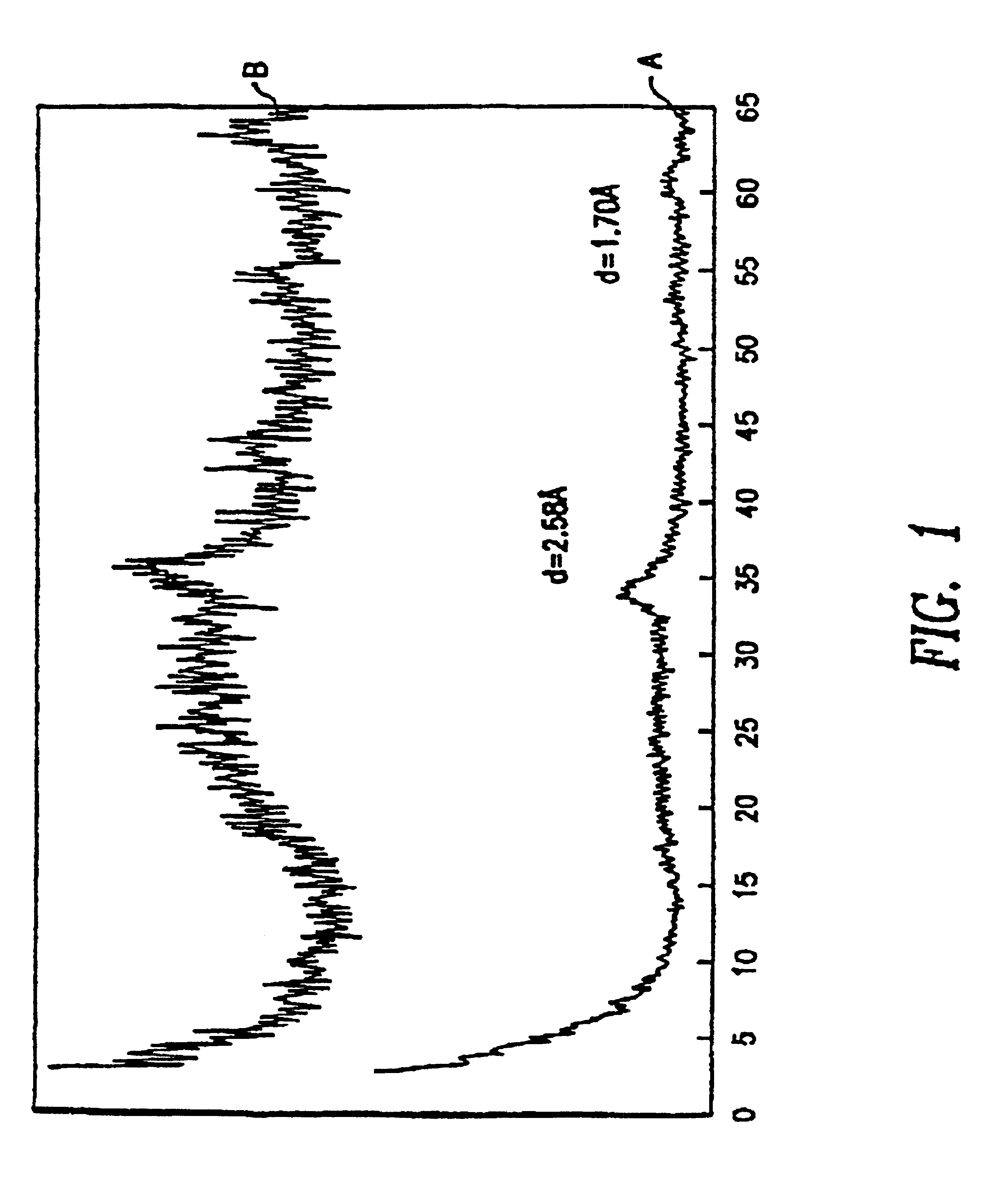Two stage process for hydrodesulfurizing distillates using bulk multimetallic catalyst
- Summary
- Abstract
- Description
- Claims
- Application Information
AI Technical Summary
Benefits of technology
Problems solved by technology
Method used
Image
Examples
example 1
Preparation of NH4—Ni—Mo—O Phase (Boiling Decomposition as per Teichner and Astier Procedure)
[0088]In a 1 liter flask, 26.5 g ammonium molybdate (0.15 moles Mo) and 43.6 g nickel nitrate hexahydrate (0.15 moles Ni) were dissolved in 300 cc of water so that the resulting pH equaled 4.3. To this solution, a concentrated NH4OH solution was added. At first, a precipitate formed which on further addition of NH4OH dissolved to give a clear blue solution with a pH of 8.3, and additional NH4OH (˜250 cc) was added until a pH of 10 was reached. The solution was heated to 90° C. for 3 h during which ammonia gas evolved and a green precipitate formed. The final pH lay between 6.8 and 7. The suspension was cooled to room temperature, filtered, washed with water and dried at 120° C. overnight. About 18.6 g of material was obtained. The sample analyzed for Ni at 26.6 wt. % and Mo at 34 wt. %. The X-ray diffraction spectra of the phase matches the pattern reported by Teichner and Astier.
example 2
Preparation of NH4—Ni—Mo.5W0.5—O by Boiling Decomposition
[0089]In a 1 liter flask, 13.2 g ammonium molybdate (0.075 moles Mo), 18.7 g ammonium metatungstate (0.075 moles W) and 43.6 g nickel nitrate hexahydrate (0.15 moles Ni) were dissolved in 300 cc of water so that the resulting pH equaled 4.3. To this solution, a concentrated NH4OH solution (˜600 cc) was added until the pH reached 10. At this point, some precipitate remained. The solution was refluxed at ˜100° C. for 3 h. During this heating, the precipitate dissolved to give a clear blue solution and on further heating, a green precipitate formed. The heating was continued until the pH reached between 6.8 and 7. The suspension was cooled to room temperature, filtered, washed with water and dried at 120° C. overnight. 18 grams of material is obtained. The X-ray diffraction spectra of the phase is given in FIG. 1 showing an amorphous background with the two largest peaks at d=2.53 and 1.70 Å.
example 3
Preparation of NH4—Ni—Mo.5W0.5—O by Direct Precipitation
[0090]In a 1 liter flask, 17.65 g of ammonium molybdate (0.1 mole Mo) and 24.60 g of ammonium metatungstate (0.1 mole W) were dissolved in 800 cc of water giving a solution pH of ˜5.2. To this solution 0.4 moles of NH4OH (˜30 cc) was added, raising the pH to ˜9.8 (solution A). This solution was warmed to 90° C. A second solution was prepared by adding 58.2 g of nickel nitrate, (0.2 moles Ni) which was dissolved in 50 cc of water (solution B) and maintained at 90° C. This solution was added dropwise at a rate of 7 cc / min into the ammonium molybdate / ammonium metatungstate solution. A precipitate begins to form after ¼ of the solution was added. This suspension which was at a pH ˜6.5 was stirred for 30 minutes while the temperature was maintained at 90° C. The material was filtered hot, washed with hot water, and dried at 120° C. Approximately 38 g of material was recovered.
PUM
| Property | Measurement | Unit |
|---|---|---|
| Temperature | aaaaa | aaaaa |
| Temperature | aaaaa | aaaaa |
| Temperature | aaaaa | aaaaa |
Abstract
Description
Claims
Application Information
 Login to View More
Login to View More - R&D
- Intellectual Property
- Life Sciences
- Materials
- Tech Scout
- Unparalleled Data Quality
- Higher Quality Content
- 60% Fewer Hallucinations
Browse by: Latest US Patents, China's latest patents, Technical Efficacy Thesaurus, Application Domain, Technology Topic, Popular Technical Reports.
© 2025 PatSnap. All rights reserved.Legal|Privacy policy|Modern Slavery Act Transparency Statement|Sitemap|About US| Contact US: help@patsnap.com


